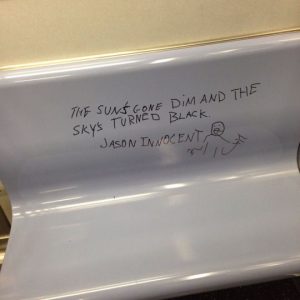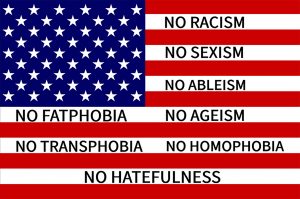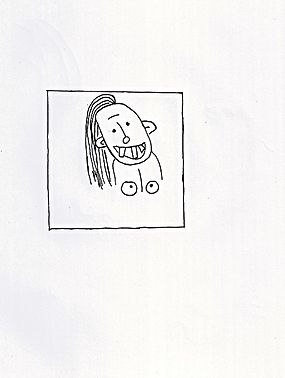The art of the young artist Jason Innocent has stood out for its juxtaposition between drawing and textual language to address political and social issues from a satirical and childlike approach. Innocent began to attract the attention of the art scene from the beginning because of his graffiti around New York City that served as his canvas, under the anonymity. Since then, he has had a rapid rise in his emerging career with notable works such as the poster “Egomaniac Donald Trump”, “39 Drawing”, and “American Flag”. Recently, he made a mini-documentary called “Masculinity”.

Innocent was born in Brooklyn, New York, of Haitian descent. Attracted to artistic expression since childhood, he has found in art a way to channel and interpret the reality around him. Inspired mainly by his hometown, he has been in charge of creating compelling images that criticize social stereotypes, racism, class struggle, power structures, stigmatization, among others. Through stencil and graffiti combined with short sentences or words, the artist has found a way to promote social change. This artistic practice has been considered a tool of struggle and social visibility – in a wrong way – since its origins in the late 1960s in the Bronx, a neighborhood where mostly African American and Latino migrants lived in conditions of poverty and violence.
The use of graffiti represents a transgression of the established order on both a social and artistic level. In 2016, Innocent created a poster during Donald Trump’s election campaign, together with Alex Wong, the photographer Getty Image. It consisted of an image of the current president of the United States with the phrase Ego Maniac on his face. This work not only represents his anti-Trump stance but also proposes a reflection on the importance of the vote and how it impacts on society. The essence of urban art is latent in the public-performance dimension of the posters distributed on the streets of Chinatown, New York, Soho and Lower East Side, East Village, and in the use of spray paint in the phrases. In this way, it is configured within the qualities of public art since the work functions a discourse in situ.

The importance of the word runs through Innocent’s works that go beyond the expressiveness of calligraphy in graffiti. The power of words can be view in his work “American Flag,” in which the artist re-interprets the American flag and questions what it represents for citizens. Behind his image, the flag may serve for some nationalistic pride or the American dream, while for others, it means social inequality. Using unorthodox typography, he created a banner that includes the words NO RACISM, NO SEXISM, NO ABLEISM, NO FATPHOBIA, NO AGEISM, NO TRANSPHOBIA, NO HOMOPHOBIA, and NO HATEFULNESS.
This correlation between image and word has had its peak in the historical avant-gardes at the beginning of the last century, mainly Dadaism, Surrealism, and Cubism. These movements have challenged the very concept of art by breaking with the conventions of image representation. Together with the new theories of language, artists used the resource of the word through titles of their works to elaborate a concept beyond the visual object. Jason Innocent, on the other hand, has developed a particular style of writing of a childish nature that conveys his youthful impulse and spontaneity. In “39 Drawing”, the word also dialogues with the childlike drawing.
In the production mentioned above, Innocent shows a collection of drawings and phrases made during his adolescence. In these works, the artist explores writing in its graphic expression and deconstruction: some words may be upside down or joined in a Scrabble-like manner, and the phrases may be crossed out. Through these verbal concepts, he also reflects his thoughts on social justice and racism in drawings such as “Uncle Tom,” “Origin of Negros,” and “Sweetwater Clifton.” Both the writing and the picture are constructed using minimal, curved lines to reduce the graphic sign to its most basic form. Innocent created simple figurative pencil shapes with primary colors, such as red and black, or with a colorful touch. This stripping away can be related to the philosophy behind arte povera about art as an expression that can be built from anything.

This Italian movement emerged in the late 1960s by a generation of artists who used non-traditional materials, sometimes recycled from the street. They proposed a reflection on the hierarchy of artistic elements, the process of manufacturing work, and the rejection of consumerism, on the opposite side of pop art and minimalism. Moving away from the artifice of the hegemonic discourse of the fine arts can be understood in Jason and the Arte Povera as a way that privileges the message to be transmitted without beautiful ornaments that distract the perception of the viewer.
The almost natural aesthetics in “39 Drawing” represented in the simplicity, the poppet, and the scribbles should not be confused with naivety and technical carelessness. In Innocent, this gesture is intentional and reflects the spontaneity and intuition in the drawing. The influence of Jean-Michel Basquiat is fundamental in this aspect. The renowned artist gave his works a childlike appearance through a new pictorial style (inspired by neo-expressionism and primitivism) based on diagrams, symbols, collage, written words. In most cases, the typography is not a rejection of the word but the opposite, a call for attention of it. Also, in both, their artworks are a way to vindicate children’s drawings even if this is not the primary objective.

Finally, as mentioned at the beginning, Innocent has written and directed the short documentary film “Masculinity,” which questions the social and cultural pressures on man. This translates into the supposed qualities they must have, such as strength, virility, leadership, or coldness. Through a visual journey of interviews and archival material, it exposes how patriarchal constructions also affect men. Contemporary society is undergoing significant changes, including those led by women, which require the reconfiguration of pre-established and harmful roles. As it has been, the questioning of toxic masculinities has been carried out by feminist movements. Therefore, the documentary raises the urgency of opening up a debate in men, since it is up to them to put an end to this concept that causes so much damage to both genders.
Innocent demonstrates with his brilliant career his capacity for versatility and his power of communication. In different times where positive change and unrest coexist, art must remain socially engaged today more than ever. His brutal, explicit, and at other times childlike style makes his works a high impact visual attraction.





